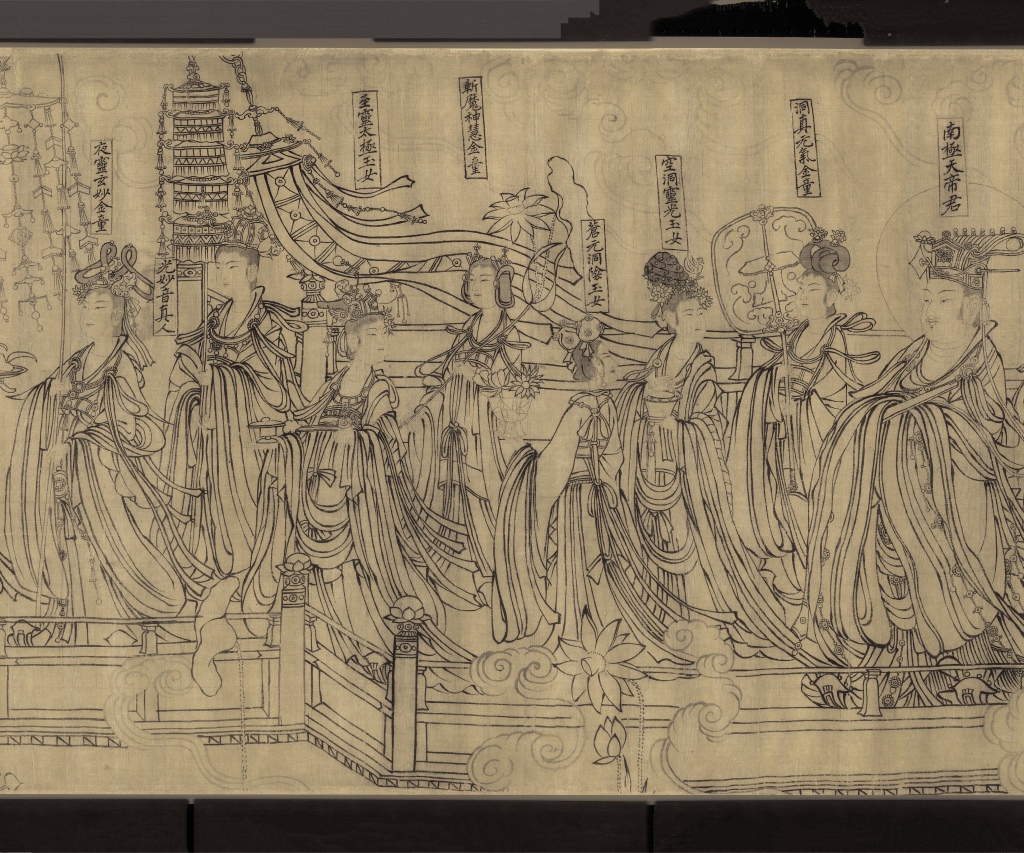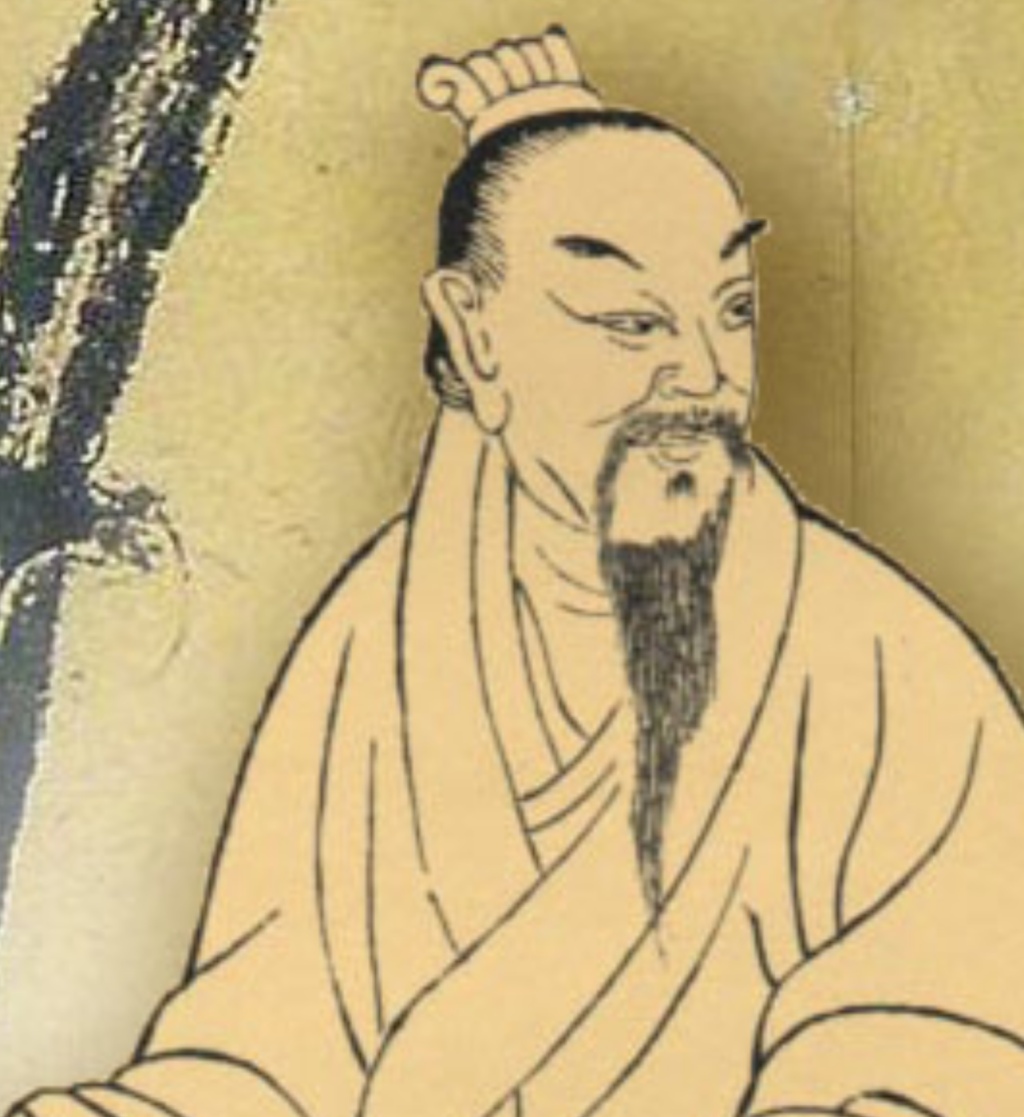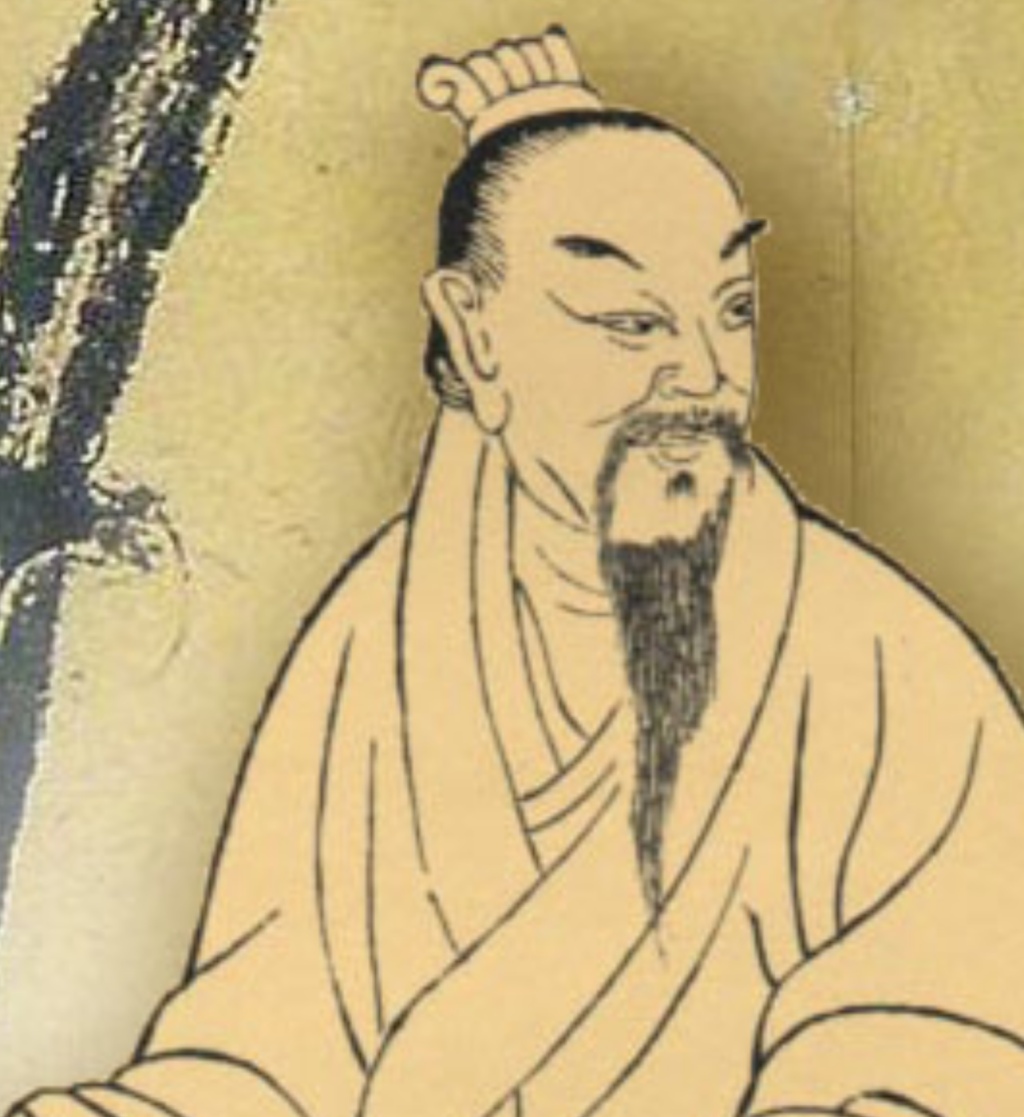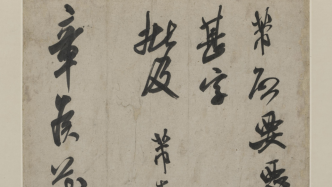
Modern and contemporary collector Cheng Qi (1911-1988) collected many famous calligraphy and paintings, the most famous of which were "The Procession of Immortals to the Source" and "Emperor Ming Huang Enjoying the Cooling" by Northern Song painter Wu Zongyuan. "Emperor Ming Huang Enjoying the Cooling" was later believed to be made by Zhang Daqian. On May 30, 2023, The Paper published an article titled "Behind the Exposing of Zhang Daqian's Forgery Methods - Taking the Study of "Emperor Ming Huang Enjoying the Cooling" as an Example". The author made several responses on Cheng Qi's collection psychology and the origin of the name "Xuanhuitang", combined with his collection of calligraphy and paintings "Xuanhuitang Calligraphy and Painting Record".

A detail of the Song Dynasty painting "Chaoyuan Xianzhang Tu" once collected by Cheng Qi
Around 2000, I spent a lot of time in Hong Kong. In Mong Kok, where second-hand bookstores are concentrated, there are several art bookstores that sell books on Chinese art, picture albums, four treasures of the study, and some old books. In those years, shop rents soared, and many bookstores were overwhelmed. Some closed down, and some changed their business. The "Shizhai" art bookstore, located on the ninth floor of an office building at the end of Beihai Road, has always stood tall.
One day at noon, I went to this bookstore to buy rice paper. When I was checking out at the cashier, I found a pile of books on one side of the counter, half a person's height. I picked it up and saw that the white book cover was still intact. There were two books in a set, and the binding was extremely beautiful. The clerk said that the printing factory didn't want them anymore and put them here; if you want them, take them away, it's free! Since it's free, I took a set. I wanted to take more, but the books were too heavy - this is the "Xuanhuitang Calligraphy and Painting Record" to be introduced below. When I came back and checked online, I was surprised to find that a certain used book website actually marked the price of 10,000 yuan. I hurried to the bookstore the next day, but there was only one set left that the boss kept for himself, and I couldn't help but feel lost. This set of books is a catalog of calligraphy and painting collections by Cheng Qi (1911-1988), a well-known modern collector. It is a photocopy of the Jiangxue Pavilion Green Grid Manuscript Yu Qing's handwriting, calfskin hardcover with gold stamping, and one copy of each of the calligraphy and painting records.

Xuanhuitang Calligraphy and Painting Records
The paintings range from the Tang Dynasty to the late Qing Dynasty. There are three paintings from the Tang Dynasty: Zhang Xuan Emperor Minghuang Enjoying the Cool, Two Paintings of Immortals by an Unknown Artist in the Late Tang Dynasty, and Nanji Xianweng; one painting from the Southern Tang Dynasty: Ju Ran's Mountain Dwelling; 14 paintings from the Song Dynasty: Yan Wengui Creek Wind, Fan Kuan's Yangtze River Thousand Miles, Song Huizong's Four Birds, Ma Yuan's Plum Blossom Book, etc.; 17 paintings from the Yuan Dynasty, including Zhao Mengfu Fish Basket, Gao Shan Liu Shui, and Luan Ju, Ke Jiusi's Secluded Bamboo and Wild Stones, Wang Mian's Ink Plum, Wang Meng's Nancun Thatched Cottage, and Wu Zhen's Clear Stream Fishing Boat, etc.; the Ming and Qing Dynasties are the majority of the paintings in the collection, with 53 Ming Dynasty painters and 66 paintings. Among them, Shen Zhou and Wen Zhengming each have five paintings, and Tang Yin, Wen Jia, Xu Wei, Lan Ying, etc. all have more than one painting. There are 49 Qing Dynasty painters in the collection, with 80 paintings. There are many paintings by the Four Wangs, Eight Eccentrics of Yangzhou and Four Monks in the early Qing Dynasty, and most of them are included in the collection.

Inside page of Xuanhuitang Calligraphy and Painting Record
The contents of the book list include: one volume of Buddhist scriptures written by people from the Six Dynasties; one volume of Buddhist scriptures written by people from the Sui Dynasty; 19 pieces of calligraphy by people from the Tang Dynasty, mainly Buddhist scriptures; 7 pieces of calligraphy from the Song Dynasty, including Su Shi's Fang Gan Poetry Scroll and Mi Fu's Ni Bai Tiezhu; 9 pieces of calligraphy from the Yuan Dynasty, 3 pieces from Zhao Mengfu, 2 pieces from Ke Jiusi and 1 piece from Zhang Yu. The Ming Dynasty has the most calligraphy, with 26 calligraphers and 37 pieces of calligraphy, basically covering all the famous calligraphers of the Ming Dynasty. Among them, Dong Qichang, Wen Zhengming and Bada Shanren have the most pieces of calligraphy, with 6 pieces, 4 pieces and 4 pieces respectively. There are 11 pieces of calligraphy from the Qing Dynasty, ending with Weng Fanggang in the late Qing Dynasty.

Cheng Qi (1911-1988), courtesy name Bofen, alias Ershi Laoren, also known as Ke'an, was originally from Shexian County, Anhui Province, and later lived in Japan to do business. His father Cheng Bingquan was a big antique dealer, and was a close friend of Pei Jingfu, a big collector from Huoqiu in the late Qing Dynasty. Cheng Qi grew up in a family of calligraphy and painting collectors, and was influenced by them. As soon as he made his debut in the 1930s, he was extraordinary. His first purchase was "Chaoyuan Xianzhang Tu" by Wu Zongyuan, a famous figure painter in the Northern Song Dynasty.

Detail of "Chaoyuan Xianzhang Tu"
Let’s first talk about this masterpiece that is not included in the “Xuanhuitang Calligraphy and Painting Record”.
The "Chaoyuan Xianzhang Tu" is a large silk painting with white ink, without the author's signature. There are four seals of Emperor Huizong of Song on the scroll, and the earliest inscription is dated the eighth year of Gandao in the Southern Song Dynasty. Zhao Mengfu's inscription in the Jiachen year of Dading believed that this was the authentic work of Emperor Wuzong of the Northern Song Dynasty, that is, the "Chaoyuan Xianzhang Tu" recorded in the "Xuanhe Huapu". Later generations also agreed with Zhao Mengfu's statement, and this scroll is also the only copy of Wuzongyuan's painting that exists today. There are 87 characters of various colors in the picture, including emperors, gods, fairies, etc. The characters are lifelike, their faces are drawn in light ink, their eyebrows are well-shaped, their manners are graceful, their expressions are elegant and ancient, and their hems and skirts are drawn in thick ink, with vigorous and long lines, winding and floating, showing the beauty of "Wu Dai Dang Feng". Although the whole picture is not colored, it makes people feel that the paper is full of light and colorful. This painting and the "Eighty-Seven Immortals" attributed to Wu Daozi and collected by Xu Beihong can be regarded as the pinnacle of ancient Chinese white-ink figure painting.

The postscript of "Chaoyuan Xianzhang Tu"
Cheng Qi treasured the "Chaoyuan Xianzhang Tu" very much, and stamped many seals on the front and back of the scroll, such as "Bofen Shending", "Ke'an Miwan", "Shuangsonglou", etc. The painting was later acquired by American Jewish antique dealer Hou Shitai, and it is unknown when Cheng sold it. In the 1950s, painter Wang Yiqian discovered this painting in Hou Shitai's antique shop in New York. Because many people thought it was a fake, the painting was placed in the shop for a long time and no one was interested in it. Wang Yiqian had a keen eye for treasures and exchanged it with six Ming and Qing Dynasty calligraphy and paintings from Hou Shitai. After Hou found out that the treasure was lost, he took Wang to court for suspected fraud. In the end, Wang won the case by using the shrewdness of Suzhou people to exploit legal loopholes.
After Wang passed away, the huge inheritance became the focus of disputes among his children, and the dispute over "Chaoyuan Xianzhang Tu" was the biggest. Wang tried to transfer this painting several times when he was alive, but failed due to disagreements. Before his death, Wang left a will that the painting should return to China, so Wang's youngest daughter took it to Shanghai and kept it in a bank safe, intending to donate it to the Shanghai Museum. Later, it was discovered that the painting had been swapped in the bank, and the children blamed each other and made a mess. To this day, the whereabouts of the real painting is still confusing and no one knows. Huang Miaozi wrote an article before his death, criticizing Wang's over-shrewdness that led to many family conflicts.
The first painting listed in the Xuanhuitang Painting and Calligraphy Record is Emperor Minghuang Enjoying the Coolness by Zhang Xuan of the Tang Dynasty. This painting was later identified as a forgery by Zhang Daqian. This is the conclusion drawn by experts after comparing the brushwork of Lady Guoguo's Spring Outing and Beating Silk, which are both recognized as authentic works of Zhang Xuan, with Emperor Minghuang Enjoying the Coolness.

"Emperor Minghuang Enjoying the Cooling" recorded in "Xuanhuitang Calligraphy and Painting Record"
The book "A Breeze Blowing Dust - A Study on Zhang Daqian's Imitation of Ancient Monuments and "Emperor Ming Emperor Enjoying the Cooling Off"" edited by Gong Li and Yu Qingrong and published by Shanghai People's Fine Arts provides a detailed analysis and summary of the circulation and authenticity of the painting.

"A Gentle Breeze Blowing Away Dust: A Study of Zhang Daqian's Imitation of Ancient Monuments and "Emperor Ming Emperor Enjoying the Cooling Off""
In an article about this book published in The Paper in 2023, titled "Uncovering Zhang Daqian's Forgery Methods - Taking the Study of Emperor Minghuang Enjoying the Cooling Off as an Example", there are some errors in the part about "guessing" the collector's mentality:
1. The author said, "After Cheng Qi purchased "Emperor Ming Huang Enjoying the Cooling Off", he named his study "Xuanhuitang", where "Xuan" refers to Zhang Xuan, which shows how much he valued this painting." Cheng Qi did value this painting, but "Xuanhuitang" has nothing to do with it. Cheng wrote very clearly in the "Preface" at the beginning of "Xuanhuitang Calligraphy and Painting Record" that the name "Xuanhui" was to commemorate his mother, "to express his admiration for her."

Emperor Minghuang Enjoying the Cool
2. The author said that in the painting Emperor Minghuang Enjoying the Coolness there is the inscription of Bai Pu's "Song of Everlasting Regret" "I wish to be a pair of wings in the sky, and a pair of branches on the ground". The time when "Song of Everlasting Regret" was produced was several decades later than the time when Zhang Xuan lived. Zhang Xuan was no longer alive when "Song of Everlasting Regret" came out, and so on, and thus concluded that discovering this kind of "time dislocation" flaw is a "hard skill" in the appraisal of ancient calligraphy and paintings. In fact, Cheng Qi wrote very clearly in the painting record that these two lines of words were written later by people in the Southern Tang Dynasty!
3. The author talks about how collectors like Cheng Qi, after buying fake paintings, "deceive themselves and others, generalize from a single case", saying "What is intriguing is that when photography technology matured in the 20th century, he insisted on following the ancient system in his "Calligraphy and Painting Records", recording only texts without inserting pictures..." This is really a slander of the ancients with the modern mind. Huang Junshi, the editor of "Calligraphy and Painting Records", said very clearly in his article recalling Cheng Qi: Cheng Qi compiled the "Calligraphy and Painting Records" in order to admire the ancients and follow the traditional rules. He completely followed the form of ancient calligraphy and painting records, recording in text without inserting pictures.

Part of "Record of the Reconstruction of the Sanqing Hall in Xuanmiao Temple" by Zhao Mengfu
Cheng Qi is a student of Mr. Fu Zengxiang. He has a very good foundation in traditional Chinese studies. His postscripts are concise and clear, and his research is precise and detailed. He is very rigorous. His insights are far beyond those of ordinary antique dealers. This "Xuanhuitang Calligraphy and Painting Record" can follow the traditional rules, but its meticulousness is beyond the ordinary calligraphy and painting records. Unlike ordinary collectors who speculate for profit, although Cheng Qi is an antique dealer, his respect for traditional culture is far greater than that of ordinary collectors who buy and sell for profit. He is a real calligraphy and painting collector. He takes good care of the unforgettable masterpieces he handles, and never hesitates to repair and remount them. He often asks the famous Japanese mounter Meguro, who charges the highest fees in the world, to mount them three times.
Cheng Qi’s collection of calligraphy by literati and painters of all dynasties is magnificent, and he attaches great importance to the letters of calligraphers and painters of all dynasties. Among the book records, Mi Fu’s “Nan Bai Tie” and Zhou Bangyan’s “Te Ru Tie” are the most famous. The latter is the only calligraphy handed down by the poet, and was engraved into the San Xi Tang Fa Tie. Xuan Hui Tang’s collection of calligraphy by Liu Zhi, Ouyang Xiu, Lu You, Zhang Jizhi, Wu Ju, Wu Shuo, Fan Chengda, Ye Mengde and dozens of others from the Song and Yuan dynasties. Su Shi’s “Kunyang City Fu Scroll” and “Book Fang Gan Poem Scroll”, Zhao Mengfu’s “Lin Lanting Preface” and “Xuan Miao Temple Reconstruction Sanqing Hall Record” are all rare treasures. As for the latter, it appeared at Sotheby’s in the 1980s. Before the auction, some experts believed it was a fake. Wang Yiqian did not comment after seeing it, so the auction item was placed in the warehouse for a year. When it was auctioned in 1985, Huang Junshi informed Cheng Qi, and it was finally bought by Cheng Qi for 70,000 US dollars. Wang Yiqian felt extremely regretful when he found out about this. This also shows the difference in their styles of collecting calligraphy and paintings.

Mi Fu's "Nian Bai Tie"

A partial view of the scroll "South Village Thatched Cottage" collected by Xuanhuitang
The Xuanhuitang Calligraphy and Painting Record consists of two large volumes, all of which are written in neat and tidy small regular script by Hong Kong calligrapher Pan Fumin. After the book was published in 1972, Cheng Qi bought some important collections, such as Su Shi's Kunyang City Fu Scroll and Song Huizong's Jinying Autumn Birds, which were later collected in the Calligraphy of the Four Dynasties of Song, Yuan, Ming and Qing printed by Cheng in his later years.
Cheng Qi often used the following studio names: "Juyan Pavilion" was inspired by the landscapes of Ju Ran and Yan Wengui; "Shuangsonglou" refers to the Song editions of "Book of the Former Han Dynasty" and "Book of the Later Han Dynasty"; "Jiangxue Pavilion" was because he obtained seven volumes of Song Dynasty rubbings from Zhao Songxue's collection (Huang Junshi's article said that this studio name was also related to these two sets of Song edition books, because both books were once collected by Zhao Mengfu's Songxue Studio, and they were also Qian Qianyi's Jiangyun Tower. "Jiangxue Pavilion" was taken from the names of Jiangyun Tower and Songxue Studio, which is wrong. The "Calligraphy and Painting Record" has a clear explanation of the origin of Jiangxue Pavilion). The preface of "Calligraphy and Painting Record" lists the principles for stamping these studio names on calligraphy and painting, mainly the age and type.

Inside page of Xuanhuitang Calligraphy and Painting Record
Cheng Qi had a close relationship with Sheng Shengyi, the seventh son of Sheng Xuanhuai. After moving to Japan in 1950, he often interacted with Sheng Shengyi. In his later years in Japan, Sheng was poor and miserable, and most of his belongings were sold to Cheng Qi. The most precious of these were the correspondence between Sheng Xuanhuai and his friends, which totaled 77 volumes. This set of materials was finally transferred to the Chinese University of Hong Kong, and has been published in recent years.
Cheng Qi lived in San Francisco in his later years. Xuanhuitang's collections have been gradually released since the 1970s and have appeared in the auction market, often attracting high bids, which shows Cheng's vision and level of collection.
In 2003, Lin Baili from Taiwan, China, purchased the ancient calligraphy and paintings of Xuanhuitang from the descendants of Cheng Qi for US$42 million, thus becoming a giant in the Chinese collection circle. In recent years, Cheng's collection has returned to the domestic auction market many times, especially in the Guardian Four Seasons Chinese Ancient Calligraphy and Painting Auction in December 2005, which had more than 90 pieces from Xuanhuitang's old collection. As for how many of Cheng's collections of calligraphy and paintings have not yet been released, it is unknown.
As for why "Xuanhuitang Calligraphy and Painting Record" can be sold at such a high price, the reason is very simple. It has become a reference for tracing the authenticity of calligraphy and painting collections and auctions.
(The author is a researcher of literature and history)


